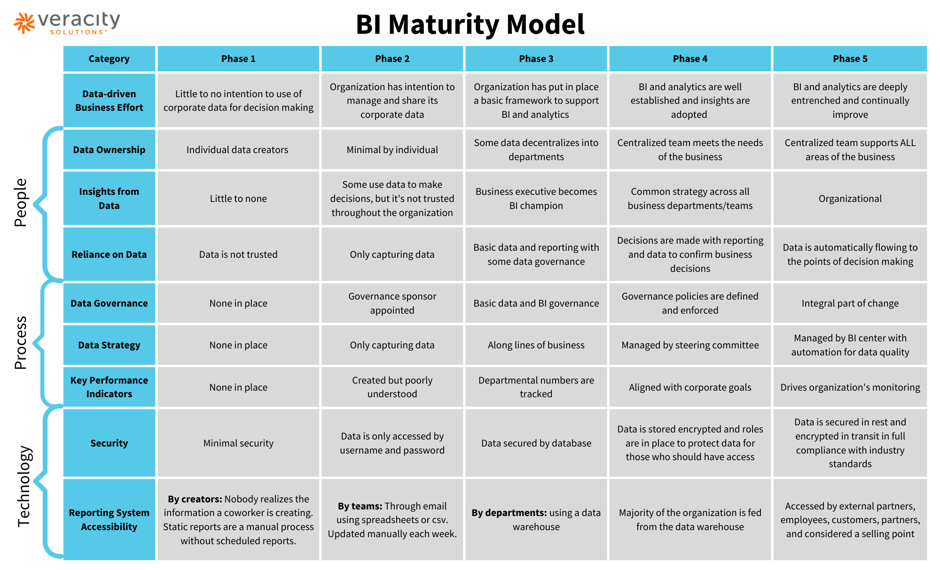If we were to ask organizations where they felt they were with their data maturity, they would rate themselves much higher than they are. The question is why does that matter? If an organization feels like they are utilizing data-generated insights, and the business is doing well, why does it matter how mature they are in their data practices?
In 2018, Gartner research indicated that more than 87 percent of organizations are classified as having low business intelligence (BI) and analytics maturity (Susan Moore, n.d.). A study published on cognopia.com indicates that 56 percent of employees believe "data-driven" is just a slogan in their company.
Where is the disconnect? Are business leaders overestimating their utilization of data-driven insights and business intelligence?
From Intuition to Data-Driven
Einstein once said: “The intuitive mind is a sacred gift.” Though trusting your gut and acting on intuition can be an extremely helpful skill, bringing data into decision making is key to efficient growth. According to research from EY, 81 percent of businesses agree that data should be at the heart of all decision making. A 2017 study conducted by Gartner, found that companies with the greatest overall growth in revenue and earnings receive a significant proportion of that boost from data and analytics (McKinsey, n.d.). Statistics like these, along with an increase in data availability, have inspired companies to make a greater effort in bringing smarter data practices into the organization.
Taking an honest view into your company’s data practices and evaluating where you fall on the Business Intelligence Maturity Model is critical to understanding what processes you currently have in place, what processes you could currently implement, and the future processes needed to gain a competitive advantage.
The Early Stages of Business Intelligence

When it comes to data and reporting methodologies, our experience is that most companies fall in Phase 1 or Phase 2 of the maturity model. However, when business executives take ownership and become BI champions (a key element in the third phase of the model) growth then becomes explosive.
Once you get executive buy-in to adopt data and reporting standards, the task to implement best practices across the whole organization becomes much easier. The company takes a holistic approach to data across the business and implements architectural standards within Data Warehouses and Data Lakes. This allows for data and reporting to be shared across departments, giving executives more information to make data-driven decisions transforming the organization into a data-driven business.
Becoming a Data-Driven Business
Knowing where you currently sit within the maturity model will help you start to lay out a plan of where to drive efforts. You can begin to set goals and plan out timing and cost of what it will take to get you to the next level of maturity. If you are currently in Phase 1, your next step may be to appoint a governance sponsor. This is someone who will take on the task of verifying the siloed data that is provided to departments is correct and being provided to the appropriate people. This will eventually lead to a Business Intelligence Competency Center being created to ensure master data management and data quality processes are in place so data can be verified and trusted throughout the whole organization.
The process of moving from one phase to the next may take considerable time and require buy-in from business executives; however, benefits will begin to manifest quickly. The result is an agile, efficient, data-driven business generating more revenue and innovating beyond what was previously thought possible.
.png?width=264&name=BI%20Webinar%20LI%20Promotion%20(5).png)
Diagnosing Your Business Intelligence
Again, without first knowing where you are, it is very hard to know where you need to go. Veracity Solutions has developed an easy way to help you identify your current business intelligence position. Our online assessment features ten multiple-choice questions mapped to the Business Intelligence Maturity Model. Upon completion, you’ll receive a customized report with recommendations on how to increase your BI maturity and data utilization.
About Veracity Solutions
Veracity Solutions transforms companies through digital technologies, enabling them to innovate now and into the future. We are a cloud-native technology services provider, specializing in helping companies in highly regulated environments accelerate digital transformation. Our five studios offer the core services, expertise, coaching, and technology that are essential to a transformative journey.
Our Data Engineering Studio serves organizations with insights and custom and pre-built solutions in:
- Business intelligence
- Machine learning and artificial intelligence
- Cloud-native data strategy
- Data warehouses and data lakes


.png?width=264&name=BI%20Webinar%20LI%20Promotion%20(5).png)
